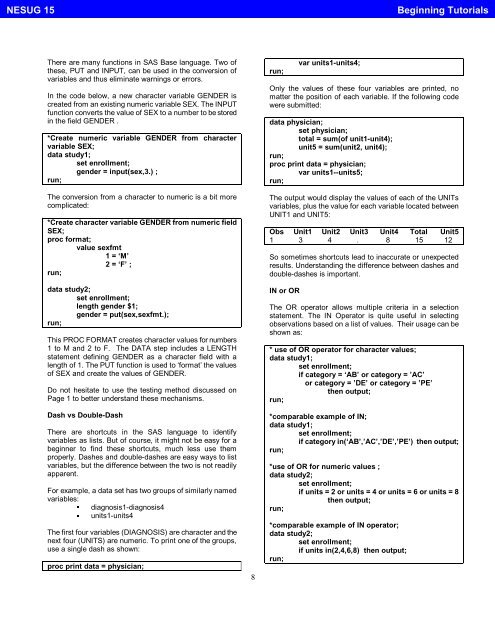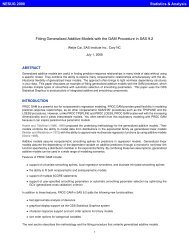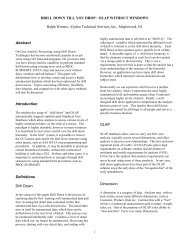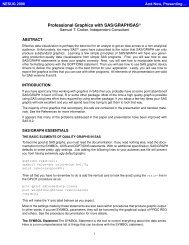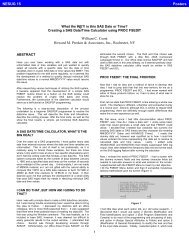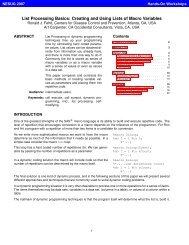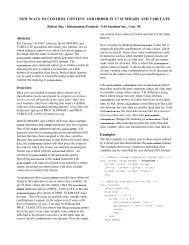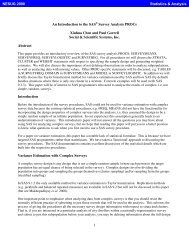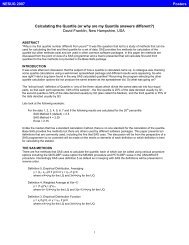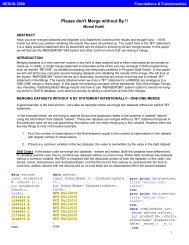<strong>NESUG</strong> 15Beginning TutorialsThere are many functions in SAS Base language. Two ofthese, PUT and INPUT, can be used in the conversion ofvariables and thus eliminate warnings or errors.In the code below, a new character variable GENDER iscreated from an existing numeric variable SEX. The INPUTfunction converts the value of SEX to a number to be storedin the field GENDER .*Create numeric variable GENDER from charactervariable SEX;data study1;set enrollment;gender = input(sex,3.) ;run;The conversion from a character to numeric is a bit morecomplicated:*Create character variable GENDER from numeric fieldSEX;proc <strong>for</strong>mat;value sexfmt1=‘M’2=‘F’;run;data study2;set enrollment;length gender $1;gender = put(sex,sexfmt.);run;This PROC FORMAT creates character values <strong>for</strong> numbers1toMand2toF. TheDATAstepincludesaLENGTHstatement defining GENDER as a character field with alength of 1. The PUT function is used to ‘<strong>for</strong>mat’ the valuesof SEX and create the values of GENDER.Do not hesitate to use the testing method discussed onPage 1 to better understand these mechanisms.Dash vs Double-DashThere are shortcuts in the SAS language to identifyvariables as lists. But of course, it might not be easy <strong>for</strong> abeginner to find these shortcuts, much less use themproperly. Dashes and double-dashes are easy ways to listvariables, but the difference between the two is not readilyapparent.For example, a data set has two groups of similarly namedvariables: diagnosis1-diagnosis4units1-units4§The first four variables (DIAGNOSIS) are character and thenext four (UNITS) are numeric. To print one of the groups,use a single dash as shown:proc print data = physician;8run;var units1-units4;Only the values of these four variables are printed, nomatter the position of each variable. If the following codewere submitted:data physician;set physician;total = sum(of unit1-unit4);unit5 = sum(unit2, unit4);run;proc print data = physician;var units1--units5;run;The output would display the values of each of the UNITsvariables, plus the value <strong>for</strong> each variable located betweenUNIT1 and UNIT5:Obs Unit1 Unit2 Unit3 Unit4 Total Unit51 3 4 . 8 15 12So sometimes shortcuts lead to inaccurate or unexpectedresults. Understanding the difference between dashes anddouble-dashes is important.IN or ORThe OR operator allows multiple criteria in a selectionstatement. The IN Operator is quite useful in selectingobservations based on a list of values. Their usage can beshown as:* use of OR operator <strong>for</strong> character values;data study1;set enrollment;if category = ‘AB’ or category = ’AC’or category = ’DE’ or category = ’PE’then output;run;*comparable example of IN;data study1;set enrollment;if category in(‘AB’,’AC’,’DE’,’PE’) then output;run;*use of OR <strong>for</strong> numeric values ;data study2;set enrollment;if units = 2 or units = 4 or units = 6 or units = 8then output;run;*comparable example of IN operator;data study2;set enrollment;if units in(2,4,6,8) then output;run;
<strong>NESUG</strong> 15Beginning TutorialsThe following code does not produce the same output dataset:*Example #1 - incorrect use of OR <strong>for</strong> character values;data study1;set enrollment;if category = ‘AB’ or ’AC’ or ’DE’ or ’PE’then output;run;*Example #2 - incorrect use of OR <strong>for</strong> numeric values;data study2;set enrollment;if units = 2 or 4 or 6 or 8then output;run;In the first example, where the OR operator is incorrectlyused <strong>for</strong> character values, the resulting data set STUDY1contains all observations where CATEGORY = ‘AB’. TheLOG contains lines such as:NOTE: invalid numeric data, ‘AC’, at line 4, column 24.NOTE: invalid numeric data, ‘DE’, at line 4, column 32.NOTE: invalid numeric data, ‘PE’, at line 4, column 40.ERROR: Limit set by ERRORS= options reached. Furthererrors of this type will not be printed.In Example #2 showing the OR operator incorrectly usedwith numeric values, the output data set STUDY2 containsall observations in the input data set ENROLLMENT. Thevalue 4 is evaluated as true (not equal to 0) and there<strong>for</strong>e allobservations are selected.Although in Version 6 there were efficiency differencesbetween IN and OR operations, those concerns no longerapply. Use the IN operator often. The examples above showthe IN operator as part of an IF statement. It is also possibleto use IN and WHERE together. The example below showsa WHERE statement that contains both an IN operator anda substring function:*example of IN operator <strong>for</strong> numeric values;proc freq data = cy00.hospital;tables provider;where substr(category,1,1) in(‘A’,’D’,’E’);run;This code is an example of the power and flexibility of SAS.The result of the program is a frequency of providers whoserecords have a category of service beginning with A, D, orE. It is very efficient programming as it selects observationsand produces output within one step.Sorting <strong>Data</strong> SetsIt is often necessary to sort a SAS data set to correctlymerge files or create a BY variable process. PROC SORTis an intense utilizer of system resources.In testing <strong>for</strong> this paper, the following three programs wererun and showed little or no difference in CPU use:*Example1–WHEREdatasetoption;proc sort data = cy00.hospital(where = (substr(diagnosis,1,2) = ‘65’))out = hospital;by hospital;keep hospital diagnosis units cost1;run;*Example2–WHEREstatement;proc sort data = cy00.hospital out = hospital;where substr(diagnosis,1,2) = ’65’;by hospital;keep hospital diagnosis units cost1;run;*Example3–IFstatement;data hospital;set cy00.hospital;keep hospital diagnosis units cost1;if substr(diagnosis,1,2) = ‘65’;run;proc sort data = hospital;by hospital;run;All three examples took similar CPU time and produce anoutput data set HOSPITAL with 4 variables (keephospital diagnosis units cost1;) and observationsmeeting the subset criteria (if substr(diagnosis,1,2) =‘65’;). Clearly, if additional manipulation of the data setwere required, then the code in Example #3 is the best.If a data set has already been sorted and later needs to beunduplicated by the BY variable, there are two differentmethods that can be used:*Example #1 – SORT with NODUPKEY option;proc sort data = cy00.hospital out = hospitalnodupkey;by hospital;run;*Example #2 – IF and FIRST.variable – data set mustbe presorted;data hospital;set cy00.hospital;by hospital;keep hospital diagnosis units cost1;if first.hospital;run;Tests of these two programs in SAS Version 8 showedthat the second example, using the IF and theFIRST.variable, were much more efficient than the PROCSORT with the UNDUPKEY option.9


